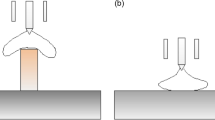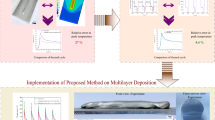Abstract
In this study, we have developed a numerical model of the pulsed tungsten inert gas (TIG) arc, with a primary focus on the influence of the ambient atmosphere in wire arc additive manufacturing (WAAM), which is more approached to practical instances. The arc plasma behaviour and air transport during the pulsed TIG-based WAAM are investigated, and the effects of the nozzle diameter on the air transport are examined. It is indicated that the air is transported significantly into the zone near the sidewall of the AM buildup. Both the air concentration and the arc temperature vary periodically with the pulsed current, whereas the change in the air distributions noticeably falls behind that in the arc temperature fields. The variation in the air concentration is mainly caused by the backward flow of the arc plasma near the sidewall of the build, which varies periodically with the arc current and transports the air into the vicinity of the sidewall. Such an effect is an essential source of oxygen for the oxidation and contamination of the deposition layer during the WAAM process. Increasing the nozzle diameter can effectively lower air concentration near the build’s sidewall, suggesting an enhancement in both shielding effectiveness and part quality. Our simulated outcomes are in reasonable consistency with experimental measurements, encompassing both arc plasma flow as observed through shadowgraphy imaging and the element distribution gauged via EDS line scans of the oxide layer formed during the build’s deposition.

















Similar content being viewed by others
References
Cunningham CR, Flynn JM, Shokrani A, Dhokia V, Newman ST (2018) Invited review article: strategies and processes for high quality wire arc additive manufacturing. Add Manuf 22:672–686. https://doi.org/10.1016/j.addma.2018.06.020
Williams SW, Martina F, Addison AC, Ding J, Pardal G, Colegrove P (2016) Wire + arc additive manufacturing. Mater Sci Tech 32:641–647. https://doi.org/10.1179/1743284715Y.0000000073
Traidia A, Roger F (2011) Numerical and experimental study of arc and weld pool behaviour for pulsed current GTA welding. Int J Heat Mass Transfer 54:2163–2179. https://doi.org/10.1016/j.ijheatmasstransfer.2010.12.005
Wang F, Williams S, Rush M (2011) Morphology investigation on direct current pulsed gas tungsten arc welded additive layer manufactured Ti6Al4V alloy. Int J Adv Manuf Technol 57:597–603. https://doi.org/10.1007/s00170-011-3299-1
Yilmaz O, Ugla AA (2017) Microstructure characterization of SS308LSi components manufactured by GTAW-based additive manufacturing: shaped metal deposition using pulsed current arc. Int J Adv Manuf Technol 89:13–25. https://doi.org/10.1007/s00170-016-9053-y
Ke WC, Oliveira JP, Cong BQ, Ao SS, Qi ZW, Peng B, Zeng Z (2022) Multi-layer deposition mechanism in ultra high-frequency pulsed wire arc additive manufacturing (WAAM) of NiTi shape memory alloys. Add Manuf 50:102513. https://doi.org/10.1016/j.addma.2021.102513
Zhuo Y, Yang C, Fan C, Lin S, Chen Y, Chen C, Cai X (2021) Grain refinement of wire arc additive manufactured titanium alloy by the combined method of boron addition and low frequency pulse arc. Mat Sci Eng A 805:140557. https://doi.org/10.1016/j.msea.2020.140557
DebRoy T, David SA (1995) Physical processes in fusion welding. Rev Mod Phys 67:85–112. https://doi.org/10.1103/RevModPhys.67.85
Tanaka M, Lowke JJ (2007) Predictions of weld pool profiles using plasma physics. J Phys D Appl Phys 40:R1-23. https://doi.org/10.1088/0022-3727/40/1/R01
Murphy AB, Tanaka M, Yamamoto K, Tashiro S, Sato T, Lowke JJ (2009) Modelling of thermal plasmas for arc welding: the role of the shielding gas properties and of metal vapour. J Phys D Appl Phys 42:194006 (20pp). https://doi.org/10.1088/0022-3727/42/19/194006
Cunningham CR, Flynn JM, Shokrani A, Dhokia V, Newman ST (2018) Strategies and processes for high quality wire arc additive manufacturing. Add Manuf 22:672–686. https://doi.org/10.1016/j.addma.2018.06.020
Xu X, Ding J, Ganguly S, Diao C, Williams S (2018) Oxide accumulation effects on wire + arc layer-by-layer additive manufacture process. J Mater Process Tech 252:739–750. https://doi.org/10.1016/j.jmatprotec.2017.10.030
Siewert E, Wilhelm G, Haessler M, Schein J, Hanson T, Chnick MS, Füssel U (2014) Visualization of gas flows in welding arcs by the Schlieren measuring technique. Weld J 93(1):1S-5S
Dreher M, Füssel U, Ros S, Häßler M, Hertel M, Schnick M (2013) Methods and results concerning the shielding gas flow in GMAW. Weld World 57:391–410. https://doi.org/10.1007/s40194-013-00382
Beyer V, Campbell SW, Ramsey GM, Galloway AM, Moore AJ, McPherson NA (2013) Systematic study of effect of cross-drafts and nozzle diameter on shield gas coverage in MIG welding. Sci Tech Weld Join 18:652–660. https://doi.org/10.1179/1362171813Y.0000000143
Bitharas I, McPherson NA, McGhie W, Roy D, Moore AJ (2018) Visualisation and optimisation of shielding gas coverage during gas metal arc welding. J Mater Process Tech 255:451–462. https://doi.org/10.1016/j.jmatprotec.2017.11.048
Wang X, Zhang J, Deng Y, Chen D, Trinh NQ, Tashiro S, Tanaka M (2023) Numerical investigation of arc properties in gas tungsten arc based additive manufacturing. Weld World 67:945–954. https://doi.org/10.1007/s40194-023-01473-y
Hauser T, Reisch RT, Breese PP, Nalam Y, Joshi KS, Bela K, Kamps T, Volpp J, Kaplan AFH (2021) Oxidation in wire arc additive manufacturing of aluminium alloys. Add Manuf 41:101958(11pp). https://doi.org/10.1016/j.addma.2021.101958
Murphy AB (1993) Diffusion in equilibrium mixtures of ionized gases. Phys Rev E 48:3594–3603. https://doi.org/10.1103/PhysRevE.48.3594
Murphy AB (1994) Demixing due to frictional forces in an electric arc. Phys Rev Lett 73:1797–1800. https://doi.org/10.1103/PhysRevLett.73.1797
Murphy AB (1997) Demixing in free-burning arcs. Phys Rev E 55:7473–7497. https://doi.org/10.1103/PhysRevE.55.7473
Murphy AB (1996) The influence of demixing on the properties of a free burning arc. Appl Phys Lett 69:328–330. https://doi.org/10.1063/1.118049
Wang X, Chi L, Wu G, Li C, Fan D (2019) Numerical simulation of mixture gas arc of Ar-O2. Acta Phys Sin 68:178102(10pp). https://doi.org/10.7498/aps.68.20190416
Wang X, Luo Y, Chi L, Fan D (2020) Numerical investigation of transport phenomena of arc plasma in argon-oxygen gas mixture. Int J Heat Mass Transfer 154:11970. https://doi.org/10.1016/j.ijheatmasstransfer.2020.119708
Murphy AB (2010) The effects of metal vapour in arc welding. J Phys D Appl Phys 43:434001. https://doi.org/10.1088/0022-3727/43/43/434001
Wang X, Luo Y, Wu G, Chi L, Fan D (2018) Numerical simulation of metal vapour behaviour in double electrodes TIG welding. Plasma Chem Plasma Process 38:1095–1114. https://doi.org/10.1007/s11090-018-9904-4
Murphy AB (1995) Transport coefficients of air, argon-air, nitrogen-air, and oxygen-air plasmas. Plasma Chem Plasma Process 15:279–307. https://doi.org/10.1007/BF01459700
Murphy B, Tam E (2014) Thermodynamic properties and transport coefficients of arc lamp plasmas: argon, krypton and xenon. J Phys D Appl Phys 47:295202. https://doi.org/10.1088/0022-3727/47/29/295202
Murphy AB (2012) Transport coefficients of plasmas in mixtures of nitrogen and hydrogen. Chem Phys 398:64–72. https://doi.org/10.1016/j.chemphys.2011.06.017
Murphy AB (2014) Calculation and application of combined diffusion coefficients in thermal plasmas. Sci Rep 4:4304. https://doi.org/10.1038/srep04304
Murphy AB (2001) Thermal plasmas in gas mixtures. J Phys D Appl Phys 34:R151–R173. https://doi.org/10.1088/0022-3727/34/20/201
Park H, Trautmann M, Tanaka K, Tanaka M, Murphy AB (2017) Mixing of multiple metal vapours into an arc plasma in gas tungsten arc welding of stainless steel. J Phys D Appl Phys 43:43LT03. https://doi.org/10.1088/1361-6463/aa8b06
Murphy AB, Tanaka M, Yamamoto K, Tashiro S, Lowke JJ (2010) Modelling of arc welding: the importance of including the arc plasma in the computational domain. Vacuum 85:579–584. https://doi.org/10.1016/j.vacuum.2010.08.015
Wang X, Fan D, Huang J, Huang Y (2014) A unified model of coupled arc plasma and weld pool for double electrodes TIG welding. J Phys D Appl Phys 47:275202. https://doi.org/10.1088/0022-3727/47/27/275202
Sawato H, Tashiro S, Nakata K, Tanaka M, Yamamoto E, Yamazaki K, Suzuki K (2011) Measurement of dynamical variation in two-dimensional temperature distribution of TIG pulsed-arcs. Quart J Jap Weld Soc 29:23s–26s. https://doi.org/10.2207/qjjws.29.23s
Bachmann B, Kozakov R, Gött G, Ekkert K, Bachmann JP, Marques JL, Schöpp H, Uhrlandt D, Schein J (2013) High-speed three-dimensional plasma temperature determination of axially symmetric free-burning arcs. J Phys D Appl Phys 46:125203 (16pp). https://doi.org/10.1088/0022-3727/46/12/125203
Fan H G, Na S J, Shi Y W (1997) Mathematical model of arc in pulsed current gas tungsten arc welding. J Phys D Appl Phys 30:94–102 (http://iopscience.iop.org/0022-3727/30/1/012)
Bitharas I (2018) Visualisation of shielding gas flows during high-value manufacture, PhD Thesis, Heriot-Watt University, Edinburgh, Scotland, UK EH14 4AS. https://www.ros.hw.ac.uk/handle/10399/3992. Accessed 17 Dec 2022
Ding J, Colegrove P, Martina F, Williams S, Wiktorowicz R, Palt MR (2015) Development of a laminar flow local shielding device for wire + arc additive manufacturing. J Mater Process Technol 22:99–105. https://doi.org/10.1016/j.jmatprotec.2015.07.005
Tashiro S, Trinh NQ, Suga T, Matsuda N, Tsurumaru N, Maeda T, Tanaka R, Nakatsu S, Tsujii G, Bui HV, Tanaka M (2021) Influence of cross-wind on CO2 arc welding of carbon steel. Metal 11:1677. https://doi.org/10.3390/met11111677
Tanaka M, Yamada T, Shigeta M, Komen H, Fukahori M, Saito N (2021) Experimental study on effects of gas-shielding in lap-fillet arc welding. Weld Int 35:492–507. https://doi.org/10.1080/09507116.2021.1980296
Schwedersky MB, Rosa ÁF, Okuyama MP, Silva RHG (2021) Limitations of the Schlieren technique for shielding gas flow visualization in arc welding processes. Weld World 65:1097–1105. https://doi.org/10.1007/s40194-021-01092-5
Acknowledgements
The authors are grateful to Dr. A. B. Murphy of CSIRO Manufacturing for providing arc plasma properties in Ar-air gas mixture.
Funding
The China Scholarship Council (Grant no. 202108500099), National Natural Science Foundation of China (NSFC) under grant No. 51705054, and the Joint Usage/Research Center on Joining and Welding, Osaka University.
Author information
Authors and Affiliations
Contributions
Xinxin Wang: conceptualisation, methodology and modelling, investigation, writing—original draft preparation and validation. Shinichi Tashiro: data curation, writing—reviewing and editing, software. Manabu Tanaka: visualisation, validation and supervision. Ngoc Quang Trinh: visualisation and validation.
Corresponding author
Ethics declarations
Ethics approval
The authors state that the present work is in compliance with the ethical standards.
Consent to participate
All the authors listed have approved the manuscript and consented to participate.
Consent for publication
All the authors listed have approved the manuscript and consented for publication.
Conflict of interest
The authors declare no competing interests.
Additional information
Publisher's Note
Springer Nature remains neutral with regard to jurisdictional claims in published maps and institutional affiliations.
Rights and permissions
Springer Nature or its licensor (e.g. a society or other partner) holds exclusive rights to this article under a publishing agreement with the author(s) or other rightsholder(s); author self-archiving of the accepted manuscript version of this article is solely governed by the terms of such publishing agreement and applicable law.
About this article
Cite this article
Wang, X., Tashiro, S., Tanaka, M. et al. Numerical investigation of the arc behaviour and air transport during pulsed tungsten inert gas arc-based additive manufacturing. Int J Adv Manuf Technol 128, 5385–5403 (2023). https://doi.org/10.1007/s00170-023-12233-z
Received:
Accepted:
Published:
Issue Date:
DOI: https://doi.org/10.1007/s00170-023-12233-z




